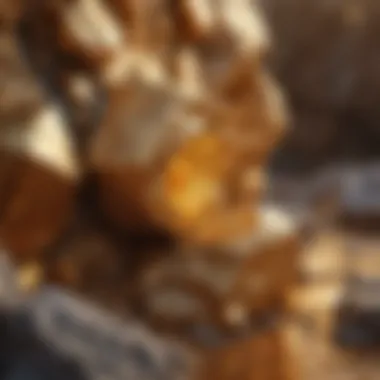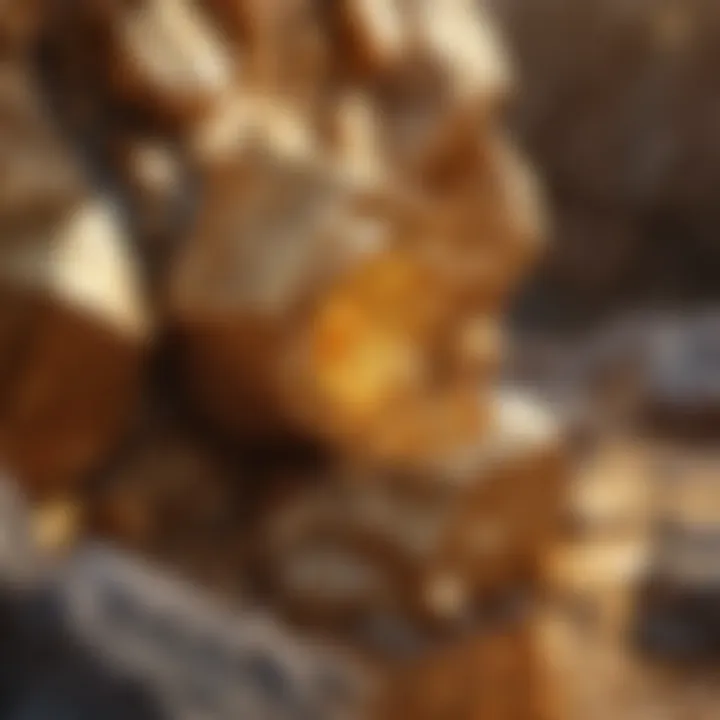Gold Formation: Understanding Origins and Processes


Intro
Gold is not just a metal; it is a key element with deep historical, economic, and scientific significance. The fascination surrounding gold creates an ongoing quest to understand its origins and how it accumulated in the Earth’s crust. Exploring this topic involves unraveling geological, chemical, and even astrophysical concepts. This introductory section sets the stage for the exploration of how and where gold forms within the Earth, considering various theories that have emerged over time.
Research Overview
Summary of Key Findings
The formation of gold is attributed to several processes that span from cosmic events to intricate geological mechanisms. Research indicates that gold is primarily formed through nuclear fusion in stars and later becomes distributed through various geological processes. Key findings highlight the following aspects:
- The contribution of supernovae in creating heavy elements, including gold.
- The role of plate tectonics and hydrothermal systems in redistributing gold within the Earth’s crust.
- The influence of volcanic activity in surface and subsurface gold deposits.
"Understanding the origin of gold enhances not only our geological knowledge but also our comprehension of cosmic events that shape our planet."
Background and Context
Gold has been coveted for thousands of years. Its rarity and properties led to its use as currency and adornment. But where does it come from? The quest to understand gold's formation can be traced back to early civilizations that admired its luster and value. Over time, scientific advancements have provided insights into the geological processes that lead to the concentration of this precious metal.
The formation of gold is linked with the broader context of Earth’s geology, including the processes that formed the Earth's crust and the distribution of minerals within it. This context is essential for understanding how gold deposits can be located and mined, which has significant economic implications. The current research landscape combines elements of geology, chemistry, and even astronomy to piece together the narrative of gold’s origins.
Methodology
Experimental Design
To study the origins of gold, researchers employ a multidisciplinary approach. This includes analyses of geological formations, simulations of stellar processes, and the study of mineral deposits. By utilizing various experimental designs, scientists can derive data that enlightens our understanding of gold formation.
Data Collection Techniques
Data can be collected through several techniques:
- Geochemical Analysis: Analyzing rock samples for traces of gold and its associated minerals.
- Geophysical Surveys: Using methods like seismic imaging to map underground structures that could store gold deposits.
- Astrophysical Simulations: Modeling the conditions necessary for gold formation during cosmic events.
Through these diverse methods, researchers develop a clearer picture of gold’s genesis and its distribution across different geological settings. This engaged approach leads to ongoing discoveries, improving our knowledge about one of the Earth's most valued resources.
Preface to Gold Formation
Understanding the formation of gold is crucial for grasping not only the elemental nature of this metal but also its significance in various fields, including geology, chemistry, and economic studies. This article aims to dissect the myriad processes involved in the genesis of gold, highlighting its origins and the conditions that have led to its accumulation in the Earth's crust. The formation of gold is intertwined with the Earth's geological activity and astrophysical occurrences, making it a rich subject of inquiry. Moreover, gold holds cultural and economic importance, serving as a symbol of wealth and a standard in many monetary systems throughout history.
In examining the formation of gold, one must consider multiple dimensions. The geological processes, including plate tectonics and sedimentary actions, set the stage for gold deposition. Likewise, chemical theories, such as the influence of hydrothermal fluids, elucidate the conditions that favor the formation of gold deposits. Finally, the astrophysical origins of gold, stemming from events like supernovae and neutron star mergers, provide context for understanding its presence on Earth.
A comprehensive exploration of gold formation thus reveals more than mere geological facts; it integrates aspects of the Earth's composition, processes of extraction, and future implications of ongoing research. Recognizing the significance of gold empowers individuals, researchers, and professionals alike to appreciate not just its value, but the complex interplay of factors leading to its formation.
The Significance of Gold
Gold transcends its elemental properties. It is revered across cultures, symbolizing power, status, and prosperity. Economically, gold serves as a sanctuary asset during times of instability. In trade, it acts as a tangible standard and a currency backbone in numerous societies.
In various fields such as electronics and medicine, gold is valued for its conductivity and biocompatibility. The versatility of this metal grants it significance beyond simple ornamentation.
Overview of the Earth's Composition
The Earth’s composition is diverse, composed mainly of iron, oxygen, silicon, and magnesium. However, trace elements like gold are interwoven within this complex structure.
- Crust: The outermost layer, varying from continental to oceanic types, houses most gold deposits. Its composition is largely silicate minerals, with gold often found in association with quartz.
- Mantle: Below the crust, the mantle consists of silicate rocks that are hotter and denser. While gold is not typically found here, it influences the crust's geological activity.
- Core: Composed of iron and nickel, the core’s influence on geology is indirect but significant for understanding overall planetary dynamics.
Gold forms when specific geological conditions align, primarily in regions rich in quartz veins and associated hydrothermal systems. Understanding the Earth’s composition provides insight into where and how gold can accumulate and helps frame future mining and exploration efforts.


Geological Processes Behind Gold Formation
Understanding the geological processes behind gold formation is essential for grasping the origins of this valuable element. Gold is not evenly distributed across the Earth’s crust; instead, its concentration is the result of a combination of geological forces and chemical interactions over geological time scales. This section explores specific processes that lead to the formation of gold deposits, highlighting their significance in the broader context of gold's availability and extraction.
Plate Tectonics and Gold Deposits
The movement of tectonic plates is fundamental to gold formation. These large sections of the Earth's crust interact at plate boundaries, leading to various geological phenomena. Subduction zones, where one plate slips beneath another, create significant heat and pressure. This environment can dissolve gold into hydrothermal fluids. When these fluids travel through fractures and faults in the Earth's crust, they can deposit gold in concentrated form, leading to the creation of ore bodies. Understanding these mechanisms is critical for identifying gold-rich regions.
Key aspects of plate tectonics in gold formation include:
- Pressure and Temperature: The intense conditions at subduction zones facilitate the leaching of gold.
- Fluid Movement: Faults and fractures provide pathways for hydrothermal fluids to circulate and deposit minerals.
By studying the relationship between tectonic processes and gold deposits, geologists can better predict where new deposits may be found.
Hydrothermal Processes
Hydrothermal processes are central to the formation of gold deposits. These processes occur when water, heated by the Earth's interior, interacts with rocks. The heated water can dissolve minerals, including gold. As this fluid moves through the crust, it can cool and lose capacity to hold solutes, leading to gold precipitation.
Important factors in hydrothermal systems include:
- Temperature and Pressure: Higher temperatures can enhance solubility of gold in fluids.
- Chemical Composition: The presence of other elements and compounds can affect precipitation.
Hydrothermal systems can create various forms of gold deposits, such as quartz-vein deposits and disseminated deposits, which have distinct characteristics and formations.
Sedimentary Processes
Sedimentary processes also play a role in the accumulation of gold. Erosion can wear down rocks containing gold, transporting the particles to new locations. Rivers and streams can then deposit these particles in sedimentary layers. Over time, these natural processes lead to the formation of placer deposits, where gold accumulates in concentrated areas, often in riverbeds or along beaches.
Key points about sedimentary processes include:
- Physical Weathering: Breakdown of rock releases gold particles into the environment.
- Concentration Mechanisms: Water flow can separate heavier gold particles from lighter materials, leading to concentration in specific areas.
These deposit formations are crucial for gold recovery techniques and are often targeted in artisanal and small-scale gold mining operations.
"The geological processes involved in gold formation are complex and multi-faceted, requiring a combination of geological and chemical understanding to fully appreciate the origins of this precious metal."
In summary, geological processes such as plate tectonics, hydrothermal systems, and sedimentary actions combine to create the conditions necessary for gold formation. Each plays an intricate role in determining the distribution and availability of gold deposits in the Earth's crust.
Chemical Theories of Gold Formation
Chemical theories play a pivotal role in understanding how gold forms and deposits occur within the Earth. These theories help in explaining the intricate processes that lead to gold accumulation in various geological settings. Understanding these processes is crucial for mining operations and for predicting potential sites of new gold deposits. By exploring the relationship between gold and various chemical processes, we can gain insights that not only enrich scientific knowledge but also inform mining practices and environmental policies.
Gold and Hydrothermal Fluids
Hydrothermal fluids are crucial in the transport and deposition of gold in the Earth's crust. These fluids are hot, mineral-rich solutions that can rise from the depths of the Earth due to volcanic activity or tectonic processes. When these fluids interact with surrounding rocks, they can dissolve metals, including gold, and carry them through cracks and fractures in the rock. As these fluids cool and their pressure decreases, the dissolved gold can precipitate, leading to the formation of gold deposits.
Key aspects of this process include:
- Temperature and Pressure: Hydrothermal systems typically involve high temperatures and pressures. Pathways created in the Earth's crust allow for the movement of these hot fluids, facilitating the transport of gold.
- Chemical Reactions: The presence of certain chemicals alters the solubility of gold. For example, the ligands in the fluid can increase gold's solubility, while changes in temperature or pH can lead to its precipitation.
- Formation of Veins: As fluids move through the crust, they can deposit gold in concentrated areas, often forming veins. These structures are significant as they can indicate economic deposits of gold.
"Hydrothermal fluids are key players in gold genesis, allowing for the migration and concentration of this precious metal in specific geological settings."
Role of Volcanism
Volcanism also plays a significant role in gold formation. The connection between volcanic activity and gold occurs primarily through the generation of hydrothermal systems. When magma rises to the Earth's surface, it can heat surrounding rocks and create conditions suitable for hydrothermal fluid formation. This interaction often results in the creation of gold-rich environments.
Aditionally, the eruption of volcanic materials can introduce new elements into the surrounding area, which may also contribute to the formation of gold. The gases released during these eruptions can react with existing minerals, sometimes enhancing the conditions for gold deposition.


Some important points regarding the role of volcanism in gold formation are:
- Heat Source: The heat from volcanic activity drives the circulation of hydrothermal fluids, enhancing the ability of these processes to transport gold.
- Reactivity of Materials: Volcanic eruptions can change the chemistry of local materials, leading to new opportunities for gold deposit formation.
- Formation of Porphyry Deposits: Many significant gold deposits are associated with porphyry systems, which are characterized by volcanic activities. These deposits are commonly found near subduction zones, where tectonic processes create suitable conditions for gold formation.
In summary, both hydrothermal fluids and volcanic processes are essential in understanding the chemical theories behind gold formation. Recognizing their interactions and roles can aid future research and mining operations.
Astrophysical Origins of Gold
The topic of astrophysical origins of gold highlights the cosmic phenomena responsible for the formation of this precious metal. Understanding these origins is crucial not only for academic interest but also for deciphering the broader context of gold in our universe. Astrophysical processes reveal insights into the elemental makeup of celestial bodies and help explain the distribution of gold and other heavy elements in the Earth's crust.
Supernova Nucleosynthesis
Supernova nucleosynthesis refers to the process through which elements heavier than iron, including gold, are created during the explosive death of massive stars. When a star exhausts its nuclear fuel, it undergoes a supernova explosion. This violent event generates conditions—such as extreme temperatures and pressures—that are conducive to nucleosynthesis. The fusion of lighter elements result in heavier elements, with gold being one of them.
The energy released in these explosions allows for rapid neutron capture, a process known as the r-process. This is significant for the formation of gold because it enables the creation of heavy isotopes in a very short time frame. Research indicates that a single supernova can produce enough gold to enrich surrounding material. This stellar alchemy contributes to the gold found on Earth and helps explain why gold is relatively rare compared to lighter elements.
The presence of gold in our planet today can be traced back to these cataclysmic events. For further reading, consider exploring Encyclopedia Britannica's overview on supernovae.
Neutron Star Mergers
Neutron star mergers represent another significant astrophysical event that contributes to the formation of gold. Neutron stars are incredibly dense remnants of supernovae. When two neutron stars collide, they create an explosion that releases a tremendous amount of energy, along with a cascade of neutrons. This event also facilitates rapid neutron capture, similar to supernova nucleosynthesis, but on an even grander scale.
The aftermath of a neutron star merger has been observed to result in the production of heavy elements, including gold. Recent studies indicate that heavy elements produced in these mergers are expelled into space, enriching interstellar dust and gas. This material eventually becomes part of new stars and planets, including Earth. The study of gravitational waves has provided new insights into these collisions, further enhancing our understanding of gold's cosmic origins.
The significance of neutron star mergers cannot be overstated—they not only contribute to the formation of gold but also aid in our understanding of the universe's evolution. For more details, you can check the relevant discussions on Reddit.
"The origin of elements in our world is written in the stars—a cosmic novel of creation that explains our existence and highlights the intricate connection between life on Earth and the universe."
In summary, the astrophysical origins of gold have profound implications for both our understanding of cosmic processes and the history of our planet. By studying phenomena like supernova nucleosynthesis and neutron star mergers, researchers continue to unveil the mysteries surrounding the genesis of this precious metal.
Distribution of Gold in the Earth's Crust
Understanding the distribution of gold within the Earth's crust is fundamental to comprehending the various processes that lead to its formation and accumulation. Gold is unevenly distributed across the planet, with specific regions containing rich deposits. This topic is crucial not just for academic purposes but also for practical applications, such as mining and economic development.
Gold-Rich Regions
Gold tends to concentrate in certain geological settings, leading to notable gold-rich regions. These locations often share common characteristics, such as the presence of hydrothermal systems, volcanic activity, or tectonic processes. Some of the most significant gold-rich areas include:
- The Witwatersrand Basin in South Africa: This site is one of the largest gold-producing areas in the world, primarily due to its unique geological history involving ancient river systems that deposited gold during the Precambrian era.
- The Carlin Trend in Nevada, USA: Known for its low-grade yet vast gold deposits, this area utilizes innovative extraction methods. The gold is often found in microscopic form within the host rock.
- The Super Pit in Kalgoorlie, Australia: A stunning example of open-pit mining, the Super Pit has produced significant amounts of gold over decades. Its formation relates to complex geological processes, including past volcanic activity.
Understanding these regions is essential for resource allocation, environmental strategies, and economic planning.
The Role of Erosion in Redistribution
Erosion plays a crucial role in the natural redistribution of gold found in the Earth's crust. Through weathering and transport, gold particles can be released from their original hosting rocks and moved to new locations. This redistribution significantly affects how gold is concentrated in alluvial deposits. Some key points regarding the impact of erosion include:
- Sediment Transport: Water and wind erosion can transport gold particles over large distances, where they accumulate in riverbeds or floodplains. This natural process is a vital consideration in placer mining.
- Concentration of Deposits: Erosion can lead to the concentration of gold in specific areas, making them prime candidates for mining operations. Over time, incessant erosion creates landscapes conducive to gold accumulation, such as river valleys.
- Impact on Ecosystems: Understanding erosion's role in gold redistribution also requires recognizing its impact on local ecosystems. Mining and resource extraction can both enhance and disrupt these natural processes.
In summary, the distribution of gold in the Earth's crust is influenced by geological phenomena and human activities. It is a complex interplay between natural processes and historical events that shapes where gold can be found and extracted.
Mining and Extraction of Gold
Mining and extraction of gold are critical topics in understanding the overall gold formation process, as they directly relate to how gold resources are accessed and utilized. Extraction methods selected by mining operations can significantly impact the efficiency and conservation of this precious metal. As demand for gold continues to rise, innovative approaches in extraction are necessary for meeting today's market needs and considering the long-term sustainability of the industry.
Traditional and Modern Mining Techniques
Gold mining has a deep-rooted history, and various techniques have evolved over time. Traditional methods, such as panning and sluicing, allowed early prospectors to manually separate gold from sediment. While these methods were effective on a small scale, they could not sustain large-scale mining operations.


In contrast, modern techniques have significantly advanced. The most prevailing methods include:
- Open-pit mining: This involves removing large quantities of earth to expose gold deposits. It enables the extraction of vast amounts of gold efficiently, although it alters the landscape considerably.
- Underground mining: Used when gold is located deeper in the earth, this method involves creating tunnels to access ore bodies. While it minimizes surface disruption, it requires robust ventilation systems and risk management due to potential hazards.
- Heap leaching: This chemical process involves stacking ore, then applying a solution to dissolve gold. It is a cost-effective method, especially for lower-grade ores, but requires careful management to prevent environmental impact.
The choice between methods hinges on several factors, including ore type, location, and market demands. Balancing these techniques can maximize resource recovery and financial returns.
Environmental Considerations
With the drive for gold extraction, environmental considerations have gained attention. Mining processes can profoundly affect local ecosystems and communities. Here are key impacts associated with gold mining:
- Deforestation: Many mining operations clear vast areas of forest land, leading to loss of biodiversity and disruption of habitats.
- Water contamination: Chemicals used in mining can leach into local water sources, harming aquatic life and posing risks to human health.
- Soil erosion: The removal of vegetation and soil structure can increase erosion, affecting agriculture and local waterways.
In response to these challenges, there is a growing emphasis on responsible mining practices. Companies are increasingly adopting:
- Sustainable mining practices: Techniques that minimize environmental impact, such as reduced water usage and waste recycling.
- Community engagement: Involving local communities in decision-making can ensure that mining activities consider social and environmental wellbeing.
- Regulatory compliance: Adhering to local and international environmental regulations is crucial for maintaining operational licenses.
"Sustainability should sit at the core of mining strategies, fostering balance between extraction processes and ecological preservation."
Culmination
In summary, mining and extraction techniques play a pivotal role in gold formation discussions. Understanding the benefits, challenges, and evolving practices within this field enhances our collective knowledge. The ability to balance profitable extraction with environmental stewardship will define the future of gold mining.
The Future of Gold Research
As the world continues to evolve, so too does our understanding of gold and its origins. The future of gold research is paramount, not only for advancing our knowledge about this precious metal, but also for shaping the industries that rely on its extraction and utilization. With rising demand for gold due to its applications in electronics, jewelry, and investment, innovative research will focus on improving mining practices and minimizing environmental impacts.
Technological Innovations in Gold Mining
Recent advancements in technology have redefined how gold is mined. These innovations aim to increase efficiency and sustainability in the extraction process. For instance, automation and robotics are becoming common in mining operations. These tools improve accuracy in resource identification and reduce human error.
New methods, like bioleaching, harness the power of microbial organisms to extract gold from ore. This is less harmful to the environment compared to traditional cyanide leaching. Likewise, advanced imaging techniques, such as 3D seismic surveys, help locate gold deposits more precisely, saving time and resources.
"Technological innovation will not only enhance our extraction methods but will also create a path toward more responsible mining practices."
Implications of Continued Research
The implications of ongoing gold research are extensive. As we unearth more information about gold’s origins and deposition processes, we may enhance the current models for resource management and allocation. This can lead to more sustainable practices in both mining and the use of gold.
Moreover, understanding gold’s formation deeper could result in economic benefits. For sectors reliant on this metal, more effective strategies can be developed through targeted research. Finally, as the scientific community understands more about the geological and chemical processes involved, future exploration efforts can be directed toward new areas, potentially leading to discoveries of previously unknown gold deposits.
Finale
The conclusion of this article serves as a critical reflection on the multifaceted subject of gold formation. It encapsulates the principal elements previously discussed, allowing readers to synthesize the information into a coherent understanding.
Gold, a significant element in both nature and human society, emerges from a complex interplay of geological and astrophysical processes. The article highlights its origins, from the depths of our Earth to cosmic events, emphasizing how these processes contribute to its present-day distribution.
Summing Up the Discovery of Gold
In summation, the discovery of gold encompasses diverse domains of knowledge, from geology to chemistry, and even extends to astrophysics. Each aspect reveals how various processes work together to create this precious metal. The formation theories discussed provide insight into the conditions that favor gold's presence in the Earth's crust.
Understanding gold's formation is not merely an academic exercise; it informs practical decision-making about its extraction and utilization. For instance, insight into geological processes may guide mining companies in optimizing exploration efforts. Accurate information surrounding gold deposits also has economic implications, influencing market stability.
Gold’s Lasting Impact on Society
Gold’s impact stretches far beyond its physical properties. Historically, it has served as a currency, a symbol of wealth, and a standard for trade. Its cultural significance cannot be understated, with locations like Fort Knox and museums dedicated to its vibrant history.
In modern times, gold continues to play a critical role in various industries, from electronics to medicine. It possesses unique properties that make it indispensable. The lasting need for gold informs ongoing research into new mining technologies and ethical extraction methods.
The combined insights on gold’s genesis, significance, and societal impact presented in this article create a framework for future studies. Understanding gold is crucial not only for academic purposes but also for addressing contemporary challenges regarding resource management and sustainability.
"Gold's journey from stellar phenomena to earth's crust illustrates not just scientific processes, but also humanity's enduring attraction to it."
In summary, the exploration of gold formation reveals not just its origins, but also the profound depths of its impact on culture and economy that resonate through time.







